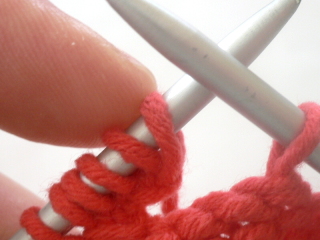You want
buttons? You gotta make buttonholes! I’m here this issue
to show you a couple of ways of making ‘em…
YO buttonhole
The simpliest button hole is to work a *yarn
over, k2tog* combination at the point on the
button band you want the button to be placed.

The result…

…is a small round
button hole.
Two-row buttonhole
The two-row buttonhole makes a slit like opening,
suitable for larger buttons.

To start, knit to the point where you want
the buttonhole to start, then cast off the
required number of stitches.

Keep in mind that knitting
stretches and so do buttonholes, so don’t
cast off more stitches than are absolutely
necessary to squeeze a button through.
On the second row: Cast on the same number
of stitches that you cast off the row before
over the same spot.

To cast on in the middle
of a row, use the backwards loop cast on
(often called “M1”)
or a knitted or cable cast on. (See here for
instructions for casting on.)
On the following row,
you might want to knit the stitches before
and after the newly cast on stitches through
the back loop…

or pick up a loose stitch and knit it together
with a neighboring stitch to tighten up any
loose stitches.
The drawbacks of the
two-row buttonhole are that it has a tendency
to stretch and - particularly in stockingette
stitch - the difference between the cast
on and cast off edges is very noticeable
and can be less than attractive…

Though in a garter stitch border this is less
noticeable, especially if you cast off in purl.
One-row buttonhole
The one hole buttonhole
is a little more complicated to work, but is a bit firmer and – done
well – neater.
When you reach the
position for the buttonhole, move the yarn
forward to the front of the work, slip 1
stitch as if to purl then return the yarn
to the back of the work, leaving a bar of
yarn in front of the stitch…

Then *slip 1 as if to purl from the left to
the right needle, and pass the second stitch
on the right needle over the first stitch,
as for casting off* Repeat from * to * for
the required number of stitches.

Now slip the last bound
off stitch from the right needle back to
the left as if to knit …

And turn the work…

Then use a knitted on, cable or backwards loop cast on …

to cast on one more stitch than you cast off.

Turn the work again to face the right side
and slip the first stitch on the left hand
needle onto the right hand needle…

Then pass the second stitch on the right hand
needle (the extra cast-on stitch) over the
just slipped stitch to finish.

The resulting button hole is less likely to
stretch than a two row buttonhole…

Though it too may benefit from a bit of ktbl
or k2tog-ing on the next row if there are any
loose stitches.
References:
- The
Knitter’s Book of Finishing Techniques by
Nancie Wiseman
- Knitter’s
Almanac by Elizabeth Zimmermann
|

